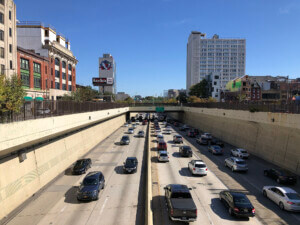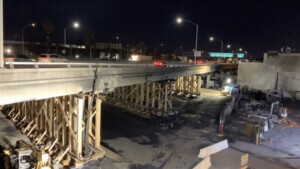Starting September 24 and running through January 5, 2020, the Tate Britain will offer visitors a new perspective on something monumental in its ubiquity: a highway.
A new life-sized replica of a stretch of the M53 highway and overpass located near Wirral, Merseyside, is coming to the museum via Turner Prize-winning artist Mark Leckey. This same stretch of pavement that he’s creating, located near his hometown, has also made an appearance in his 2015 film, Dream English Kid, 1964-1999 AD.
The replica is part sculpture and part stage set, and the structure will also be the backdrop for an audio play. The piece in both of its forms — freestanding artwork and active, designed environment — will be one of the most imposing works included in Leckey’s ambitious, large-scale exhibition for the Tate, titled O Magic Power of Bleakness.
The highway in all its ugly, functionalist glory may be the exact pulse of ‘bleakness’ that Leckey is going for in his title choice. Born in 1964, in the midst of the automobile culture boom, the artist has seen the highway become a staple of the modern commute, landscape, and mainstream imagination. The open roads and endless stretches of asphalt are at once overtly familiar, yet a deeper dive reveals and reminds that they also act as spaces of harbored secrets, sheltering the fringes of society congregating at under- and overpasses such as the section immortalized by Leckey’s sculpture.
The Tate describes the upcoming exhibition as “focusing on a group of teenagers, the play is inspired by folklore and stories of changelings and ‘fairy raids’ and by the artist’s own pre-adolescent experiences.” Described as having haunted the artist’s work throughout his career, the ominous subject of the highway has a great potential due to its sheer size and imposing materiality to exert a certain power over visitors.
Leckey has worked with collage, found objects, and video to create powerful commentary and conversations surrounding themes like nostalgia, pop cultural imagery, and anxiety. His first taste of the Tate came in 2002 — his current wife, Lizzie Carey Thomas, had accepted a job as a curator of contemporary art and asked Leckey to make a performance piece. He chose to “borrow” one of the museum’s most iconic sculptures, a Jacob Epstein work titled Jacob and the Angel. He positioned a speaker system on a pedestal nearby, laid out so the speaker and sculpture seemed to be facing off in competition. He then played music at a deafening volume. Catherine Wood, curator of performance art at the Tate, told the Guardian that “the Epstein was an iconic work I had looked at 1,000 times. Suddenly it became tender… He was possessing the museum – possessing it with our culture.” Maybe, with the re-presentation of the M53, Leckey will be able to possess the museum all over again.











